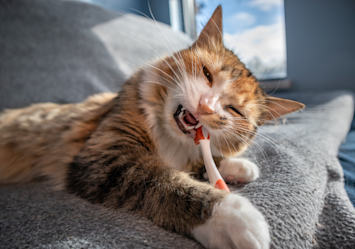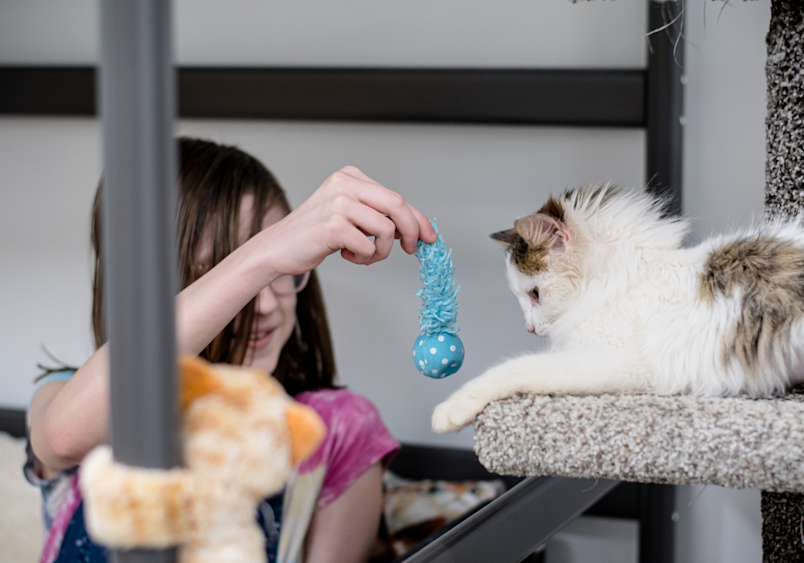
Have you ever caught your feline friend in the act of nibbling on a plastic bag or gnawing on a straw? You're not alone. Many cat owners find themselves wondering: why plastic, and is it something to worry about? In this article, we’ll discover the reasons behind this habit, explore the potential risks, and provide practical solutions to keep your kitty safe. Whether you're dealing with a casual plastic chewer or a full-blown plastic eating obsession, we've got you covered.
Why Does My Cat Eat Plastic?
Cats can be attracted to plastic for a variety of reasons. It’s not uncommon to find them chewing on grocery bags, wrappers, or plastic straws. Here are the primary reasons your cat might be obsessed with plastic:
The Sound and Texture of Plastic
Plastic often makes crinkly noises, which can stimulate your cat's senses. The texture of plastic may also feel satisfying to bite, providing sensory stimulation that they don’t get from their toys.
This sensory experience can be particularly enticing for cats, as it mimics the sound and feel of prey rustling through grass or leaves. The combination of auditory and tactile stimulation can trigger your cat's hunting instincts, making plastic an irresistible target for play and exploration.
The Scent of Plastic
Plastic bags and containers often carry food scents. Even after you’ve discarded the food, those smells linger on the plastic and can entice your cat into chewing on it. Cats have a highly developed sense of smell, far superior to humans, allowing them to detect even trace amounts of food odors on plastic items. This scent attraction can be particularly strong with plastics that contain strongly aromatic foods like fish or meat products.
Plus, some cats may be attracted to the chemical scents in certain types of plastic, which can mimic pheromones or other attractive odors.
Nutritional Deficiencies
In some cases, cats chew on non-food objects like plastic because they have nutritional deficiencies, a condition referred to as pica. Pica causes pets to seek out and chew on unusual items. This could be related to a lack of nutrients in their diet, or it might stem from deeper health issues.
Deficiencies in vitamins, minerals, or fiber can drive cats to seek out alternative sources of these nutrients, even if those sources are non-nutritive. It's important to note that pica can also be a symptom of more serious conditions such as feline leukemia, diabetes, or thyroid problems, making it vital to consult with a veterinarian if you suspect nutritional deficiencies are behind your cat's plastic-chewing behavior.
Curiosity and Boredom
Cats love to explore their environment with their mouths, and plastic is no exception. If your cat is bored or lacks stimulation, they may resort to chewing on anything they can find.
This behavior is quite common in indoor cats who don't have access to the varied stimuli of the outdoors. Plastic objects, with their interesting textures and sounds, can become a source of entertainment for an under-stimulated cat. Providing alternative activities, such as interactive toys, climbing structures, and regular play sessions, can help redirect this curiosity towards more appropriate outlets.
Stress or Anxiety
Chewing on objects can be a coping mechanism for cats experiencing anxiety. The act of chewing may provide some stress relief and comfort, much like humans might bite their nails when nervous.
Your cats may turn to plastic chewing as a way to self-soothe during stressful situations such as changes in the household, new pets, or disruptions to their routine. The repetitive action of chewing can release endorphins, providing a calming effect for anxious cats.
The Dangers of Your Cat Chewing on Plastic
Plastic may seem harmless but ingesting it can be life-threatening for your cat. Some of the risks include:
1. Intestinal Blockages
When your cat swallows plastic, it can cause blockages in their digestive system. This may require emergency surgery to remove the obstruction, especially if it's a large piece of plastic. These blockages can occur anywhere along the digestive tract, from the esophagus to the intestines. If left untreated, intestinal blockages can lead to severe pain, tissue damage, and even rupture of the intestinal wall, which can be fatal. Symptoms of a blockage may include vomiting, loss of appetite, lethargy, and abdominal pain.
2. Choking Hazard
Small pieces of plastic can become lodged in your cat's throat, causing them to choke. This is particularly dangerous if you're not around to help them. Choking can occur suddenly and silently, making it a terrifying prospect for pet owners. In severe cases, choking can lead to oxygen deprivation, which can cause brain damage or death within minutes. Even if your cat manages to dislodge the plastic on their own, the experience can be traumatic and may cause injury to their throat or esophagus.
3. Toxicity
Some plastics may contain harmful chemicals or residues that are toxic to your cat. These chemicals can cause gastrointestinal issues or other long-term health problems. For instance, plastics often contain additives like phthalates or BPA, which are known endocrine disruptors and can interfere with your cat's hormonal balance. Plus, plastic items that have been in contact with cleaning products or other household chemicals can introduce further toxins into your cat's system. Over time, repeated exposure to these toxins can lead to chronic health issues, including liver and kidney damage.

Preventing Your Cat from Eating or Chewing on Plastic
To prevent your cat from chewing on plastic and avoid the associated risks, try these preventive measures:
Keep plastic items out of reach: Store plastic bags, wrappers, and other plastic items in secure places where your cat can’t access them. This includes grocery bags, packaging, and food containers.
Provide safe alternative chew toys: Give your cat safe alternatives to chew on, such as cat-specific chew toys or dental toys. This can help satisfy their need to bite and gnaw without putting their health at risk.
Increase environmental enrichment: You can do this by increasing their mental and physical stimulation, because boredom is a common reason cats resort to chewing on plastic. Provide more designated playtime, interactive toys, puzzle feeders, or designated playtime. Cat trees, tunnels, and scratching posts can also help alleviate boredom.
Use deterrent sprays: Apply pet-safe bitter sprays to plastic items that your cat tends to chew on. These sprays have a bitter taste that cats find unpleasant, which can help deter them from chewing.
Maintain a consistent feeding schedule: Ensure your cat is getting proper nutrition and regular meals to reduce the likelihood of pica. If you suspect that your cat’s plastic-chewing behavior is due to a nutritional deficiency, consult your vet about adjusting their diet or adding supplements.
Address Stress and Anxiety: If your cat’s chewing is due to stress, try to identify the triggers and make changes to their environment. Adding vertical spaces, calming pheromone diffusers, or providing more one-on-one attention may help alleviate anxiety.
Create a "plastic-free zone": Designate certain areas of your home as completely plastic-free to give your cat safe spaces to roam.
Regular vet check-ups: Ensure your cat has routine health checks to catch any underlying issues early.
What to Do if Your Cat Eats Plastic
If you suspect your cat has ingested plastic, you’ll need to keep a close eye on them.
Monitor for Symptoms: Keep an eye out for signs of gastrointestinal distress, such as vomiting, diarrhea, lethargy, or loss of appetite.
Check the Litter Box: If your cat passes plastic in their stool, it may mean they have ingested only a small piece. However, if you don’t see any signs of the plastic passing, call your vet.
Do not induce vomiting: Do not attempt to induce vomiting unless specifically instructed by your vet, as this can sometimes cause more harm.
Contact Your Veterinarian: If your cat shows any signs of illness, contact your vet immediately. X-rays may be necessary to determine if there’s a blockage, and surgery might be required.
When to Seek Veterinary Care for Your Cat Eating Plastic
If your cat is displaying obsessive behavior toward plastic or other non-food objects, it is best to consult your vet. They can rule out any underlying health conditions and help determine whether the behavior is linked to pica or anxiety.
In severe cases, behavior-modifying drugs, such as fluoxetine, may be prescribed to help curb compulsive chewing habits. However, these medications should only be used after other medical conditions are ruled out and under your veterinarian's guidance.
Safeguarding Your Feline Friend through Pet Insurance
Considering the potential dangers of cats chewing on plastic, it’s wise to get a cat insurance quote as a safety net. Accidents can occur despite our best efforts, and if your cat’s plastic-chewing habit results in surgery or an emergency visit, having surgery coverage can alleviate financial stress. Choose a policy that has robust accident coverage, including surgeries for foreign body ingestion.
On top of that, you can add an optional, non-insurance Wellness Rewards to help you stay ahead of potential issues like pica through routine check-ups and preventive care, ensuring your furry friend gets the help they need before any problems escalate.
Keeping Your Plastic-Loving Cat Safe and Healthy
We all know by now that cats are inherently curious creatures, often exploring their surroundings in unexpected ways. While it can be amusing to watch your feline friend exhibit quirky behaviors, such as chewing on plastic, it’s essential to recognize that this habit can lead to serious health risks. From potential gastrointestinal blockages to the risk of ingesting harmful substances, the implications of a plastic-chewing cat are no laughing matter.
Understanding the reasons behind this behavior—from curiosity and boredom to potential nutritional deficiencies or stress—is crucial. By implementing preventive strategies, such as providing safe chewing toys, ensuring proper nutrition, and maintaining a plastic-free environment, you can redirect your cat's chewing habits to healthier alternatives.
Remember, while your cat's fascination with plastic may appear harmless, addressing this behavior proactively is vital. If you find that these habits persist, consulting with your veterinarian is a wise step. They can provide tailored advice and rule out any underlying health concerns.
In the end, our cats’ unique personalities and behaviors contribute to their charm. With patience, understanding, and the right precautions, you can help ensure that your plastic-loving kitty leads a happy, healthy life—because, ultimately, that’s what every cat parent aspires to achieve.